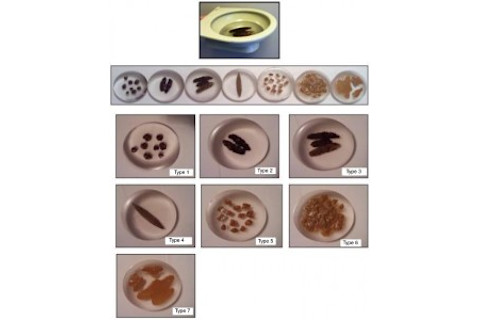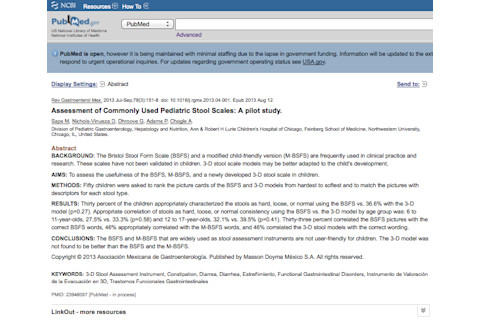
As you probably know, the Bristol Stool Form Scale (BSFS) is used to help patients, nurses, and doctors communicate about poop. (If you are one of the two people on the planet to whom I haven't already rabidly confessed my obsession with the Bristol Stool Form Scale, you can find out more about it here). But the BSFS relies on images and descriptions that may not make sense to kids. The authors of today's featured research article decided to help children visualize the BSFS, and hired an artist to turn the verbal scale ("type 1 as “rabbit droppings”, type 2 as “bunch of grapes”, type 3 as “corn on cob”, type 4 as “sausage”, type 5 as “chicken nuggets”, type 6 as “porridge”, and type 7 as “gravy”.") into 3D models (left), complete with clear resin "toilet water" and a porcelain toilet to display them. Because how else would the kids differentiate floaters from sinkers?
Assessment of Commonly Used Pediatric Stool Scales: A pilot study. "BACKGROUND: The Bristol Stool Form Scale (BSFS) and a modified child-friendly version (M-BSFS) are frequently used in clinical practice and research. These scales have not been validated in children. 3-D stool scale models may be better adapted to the child's development. AIMS: To assess the usefulness of the BSFS, M-BSFS, and a newly developed 3-D stool scale in children. METHODS: Fifty children were asked to rank the picture cards of the BSFS and 3-D models from hardest to softest and to match the pictures with descriptors for each stool type. RESULTS: Thirty percent of the children appropriately characterized the stools as hard, loose, or normal using the BSFS vs. 36.6% with the 3-D model (p=0.27). Appropriate correlation of stools as hard, loose, or normal consistency using the BSFS vs. the 3-D model by age group was: 6 to 11-year-olds, 27.5% vs. 33.3% (p=0.58) and 12 to 17-year-olds, 32.1% vs. 39.5% (p=0.41). Thirty-three percent correlated the BSFS pictures with the correct BSFS words, 46% appropriately correlated with the M-BSFS words, and 46% correlated the 3-D stool models with the correct wording. CONCLUSIONS: The BSFS and M-BSFS that are widely used as stool assessment instruments are not user-friendly for children. The 3-D model was not found to be better than the BSFS and the M-BSFS."
We especially love the description of how the 3D stool scale was developed (from the Materials and Methods section of the full text):
"A 3-D version of the BSFS was specially constructed by a local independent artist who specializes in making plastic models. He was provided with the BSFS for reference. The custom made 3-D models were constructed in resin and consisted of a 25 cm-high white mock toilet and seven 16.5 cm (diameter) × 3.5 cm (height) resin 3-D models depicting each BSFS stool type. The 3-D model included a clear material inside the mock toilet to represent water in the toilet bowl (Figure 2) and stools that “floated” or “sank” depending on the stool type. The mock toilet bowl was constructed to allow easy introduction and removal of each of the 7 types of stools from the bowl. Two focus group sessions were conducted with a group of 6 gastroenterology nurses and 6 pediatric gastroenterologists from our clinical division. Initial versions that were not immersed in clear resin (depicting water) were considered unsatisfactory by the focus group. The newer final version consisted of the stools set in clear resin which looked like stools floating/sunk in clear water in the toilet bowl. The final version of the 3-D (tridimensional stool assessment instrument) was considered to satisfactorily represent each stool type and the characteristics of children's stools."

Related content: NCBI ROFL: What your poop looks like can tell you how long it’s been inside. NCBI ROFL: FECOM: a new artificial stool for evaluating defecation. NCBI ROFL: Flatufonia–or the musical anus.













